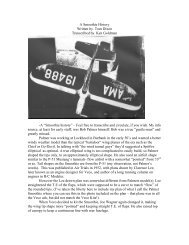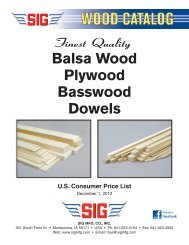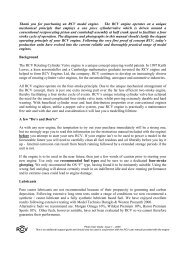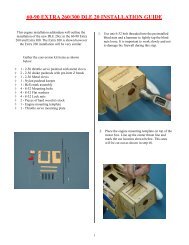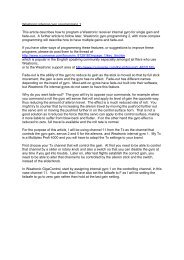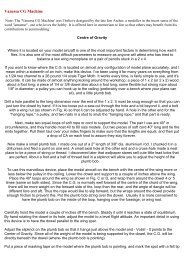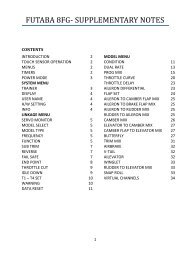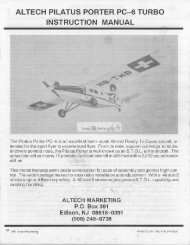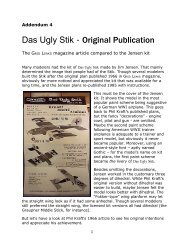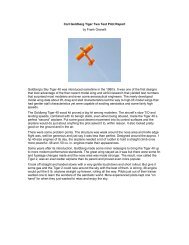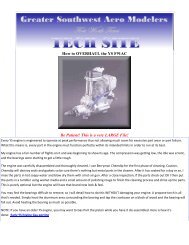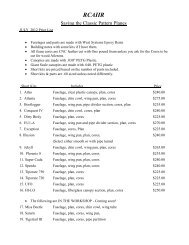Webra fuel pressure regulator Order No. 3712 - RC Universe
Webra fuel pressure regulator Order No. 3712 - RC Universe
Webra fuel pressure regulator Order No. 3712 - RC Universe
- No tags were found...
You also want an ePaper? Increase the reach of your titles
YUMPU automatically turns print PDFs into web optimized ePapers that Google loves.
2. The recommended method of mounting the<strong>pressure</strong> <strong>regulator</strong> is to use the mountingplate supplied (Fig. 4), which can be securedon top of one motor lug using the standard retainingscrews. The example illustrates onepossible option for which there is space inmost model helicopters. This method ofmounting ensures that the <strong>pressure</strong> <strong>regulator</strong>is located in the immediate vicinity of the carburettor.The shorter the link to the carburettor,the more reliable the system! The <strong>pressure</strong><strong>regulator</strong> itself is attached to the mountingplate by fitting the <strong>pressure</strong> <strong>regulator</strong> nozzlethrough the slot, and tightening the retainingnut over the shakeproof washer. Place the<strong>pressure</strong> <strong>regulator</strong> housing in the desired positionbefore tightening the nut fully. The outletnipple on the <strong>pressure</strong> <strong>regulator</strong> (marked“OUT”) can now be connected to the carburettorfeed nipple by means of a length of <strong>fuel</strong>tubing.Fig. 4Mounting plate3. Connect the <strong>fuel</strong>tank to the inlet nipple on the<strong>pressure</strong> <strong>regulator</strong> (marked “IN”) (Fig. 4). Wealways recommend that you use a <strong>fuel</strong> filter; ifyou prefer to install one outside the <strong>pressure</strong><strong>fuel</strong>tank, then it should be fitted in this <strong>fuel</strong>line.4. The next step is to connect the <strong>pressure</strong> <strong>regulator</strong>to the silencer using another length of<strong>fuel</strong> tubing. The nipple for this is located onthe rear face of the <strong>pressure</strong> <strong>regulator</strong>; connectthis to the <strong>pressure</strong> outlet nipple on thesilencer or tuned pipe (Fig. 5). The <strong>pressure</strong>line should be as short as possible; do notmake it any longer than physically necessaryto complete the connection.Fig. 5For the <strong>pressure</strong> and <strong>fuel</strong> feed lines it is important to use silicone <strong>fuel</strong> tubing with an internal diameter of2 mm or larger. Once you have completed all the connections, please check each one and ensure that it issecured properly. It is a good idea to secure the <strong>pressure</strong> lines on the nipples using hose clips.Do check that the <strong>fuel</strong>tank does not leak, i.e. is completely sealed. The system can only work effectively ifthe tank and the filler valve are effectively sealed.Starting the motorPressure needs to be built up before you start the motor. This is done by sealing the outlet of the silencer ortuned pipe with a finger for a few moments while you fire up the motor. Release the outlet pipe immediatelythe motor starts. When the motor is running, you will find that the carburettor needs to be adjusted; this isinevitable due to the change in <strong>fuel</strong> supply conditions.2



